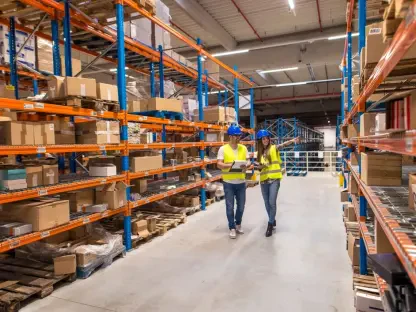In today’s challenging global trade environment, companies like 3M face significant headwinds due to tariffs. Rohit Laila, with his extensive background in logistics and supply chain management, brings deep insight into how businesses navigate these complex issues using innovative strategies and technologies.
How is 3M planning to handle the $850 million in expected tariff-related expenses this year?
3M is taking a multifaceted approach to handle these expected costs. The company is utilizing its substantial inventory, which provides a buffer against immediate impacts. By maintaining 90 days of inventory, 3M aims to reduce the financial burden of tariffs temporarily, essentially giving itself some breathing room to strategize long-term solutions. This stockpile acts as a cushion while the company evaluates more sustainable methods to offset the expense.
Specifically, how are the China-related tariffs impacting 3M’s financials and operations?
Given that China accounts for a notable part of 3M’s imports and exports, the tariffs have a significant financial and operational impact. The tariffs have increased costs substantially, which can affect pricing strategies and profit margins. This has prompted 3M to explore adjustments in its supply chain, especially regarding products sourced from or destined for China, requiring the company to swiftly adapt to these new economic pressures.
Can you provide details on how the US-Mexico-Canada Agreement tariffs are affecting 3M?
The US-Mexico-Canada Agreement-related tariffs mainly hit products that are not exempt, adding to the costs with tariffs on steel, aluminum, and other materials. This situation forces 3M to closely examine its North American supply chain dynamics, potentially influencing sourcing decisions and manufacturing loci to lessen the financial load associated with non-exempt goods under this trade agreement.
What strategies is 3M employing to mitigate these tariff costs?
3M is actively developing strategies that include adjusting product sourcing and logistics. By exploring alternative vendors and optimizing their logistics networks, they aim to lessen the tariff impact. They are leveraging their worldwide manufacturing and distribution footprint, which allows flexibility in shifting production and operational functions as needed to minimize cost burdens associated with tariffs.
How is 3M’s 90-day inventory helping to reduce the financial impact of the tariffs?
The maintained 90-day inventory serves as a temporary shield, allowing 3M to delay the immediate cost implications of tariffs. This buffer period is critical in affording the company the necessary time to devise and implement mitigation strategies without causing disruption to their supply chain or experiencing abrupt financial repercussions.
What will happen once the inventory is depleted, and how does the company plan to manage imports afterward?
As the inventory depletes, 3M is poised to feel the full brunt of tariffs unless other solutions are implemented. The company is working on various fronts—from renegotiating supplier terms to adjusting trade flows—to prepare for this eventuality. The focus is on ensuring that once the inventory cushion is gone, the impact on imports is managed through alternative strategies like supply base adjustments and operational changes.
Is 3M considering pausing orders or shipments due to these tariffs? Why or why not?
Currently, 3M is not pausing orders or shipments. The decision is likely a balance between maintaining supply chain integrity and avoiding disruptions that could lead to greater long-term costs. It’s part of their broader risk management approach to handle immediate challenges while continuing to serve their market needs effectively.
What are some of the specific product sourcing and logistics changes 3M is evaluating to reduce tariff burdens?
3M is evaluating a shift toward sourcing semi-finished products that can be completed in other regions less impacted by tariffs. They are looking at restructuring supply chains, possibly by relocating some manufacturing processes, to optimize costs. These logistics changes focus on improving flexibility and responsiveness within their global network to counteract tariff impacts.
How does 3M’s global manufacturing and distribution network provide flexibility in managing tariff impacts?
3M’s extensive global network, which includes numerous manufacturing plants and distribution centers, confers significant logistical flexibility. This setup allows the company to swiftly shift production and distribution activities to less impacted regions, effectively reducing the tariff impact by altering the flow of goods in response to shifting tariff landscapes.
Can you elaborate on the role of U.S.-based factories and supply bases in 3M’s strategy to mitigate tariffs?
Domestic facilities and supply bases play a pivotal role. These locations allow 3M to minimize reliance on imports subject to tariffs. The strategy involves maximizing local production and sourcing to ensure that the supply chain remains robust against external tariff pressures, thereby protecting their domestic market operations and reducing foreign-dependency risks.
How is 3M optimizing its trade and logistics flows, including the use of bonded facilities and free-trade zones?
3M is enhancing their logistics flows by utilizing bonded facilities and free-trade zones. These mechanisms provide financial efficiencies and lower tariff costs through deferred duty payments. By strategically incorporating these logistics models, 3M can optimize trade flows, better manage inventory, and streamline processes across their supply chain.
What are the potential benefits and challenges of shifting production to alternative sites with different countries of origin?
Shifting production can reduce tariff exposure but also comes with challenges like regulatory compliance, logistical adjustments, and potential quality control issues. However, the benefits include diversifying risk, accessing new markets, and potentially lowering costs through improved supply chain efficiencies, thus allowing for more competitive offerings.
How is 3M negotiating price adjustments with customers in response to these tariff impacts?
3M actively engages in discussions with customers to adjust prices, aiming for a transparent dialogue about the cost pressures from tariffs. They are likely working to reach mutually beneficial agreements that acknowledge the rise in production costs while trying to maintain trust and long-term relationships with their clients.
Are there any specific areas where 3M is considering making expense cuts to counteract the financial strain?
The company is likely assessing internal expenses to identify areas for cost-cutting, such as operational efficiencies or reducing discretionary spending. The goal is to balance immediate financial pressures with the need to sustain growth and investment in key initiatives that drive the business forward.
Can you describe the process and significance of the “discrete analysis” that 3M is conducting to navigate this situation?
The discrete analysis involves a deep dive into the company’s operating procedures to identify inefficiencies and opportunities for improvement. This process helps uncover hidden strengths and weaknesses in the operations, enabling more targeted and effective responses to current financial strains while optimizing overall business performance.
How is 3M balancing short-term cost-saving measures with the need to protect its long-term growth investments amid these challenges?
3M is strategically balancing short-term savings with long-term growth by prioritizing essential investments that foster innovation and competitive advantage. They are likely using a data-driven approach to identify impactful areas for cost reductions without harming core growth initiatives, ensuring they remain well-positioned amidst the ongoing tariff challenges.
Do you have any advice for our readers?
In navigating tariff challenges, it’s crucial to maintain operational agility and focus on a holistic approach to supply chain management. By diversifying supply chains, investing in technology, and maintaining a deep understanding of international trade laws, companies can better manage complexities and safeguard their competitive edge in the market.









